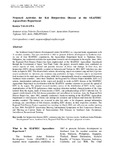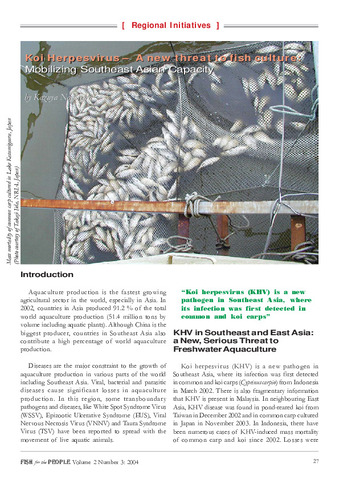Proposed activities for koi herpesvirus disease at the SEAFDEC Aquaculture Department
Share
စိတ္တဇ
The Southeast Asian Fisheries Development Center (SEAFDEC) is a regional treaty organization with 11 member countries. This was established in 1967 to promote fisheries development in Southeast Asia. As one of four SEAFDEC departments, the Aquaculture Department based in Tigbauan, Iloilo, Philippines, has conducted activities for aquaculture research and development in the region. Since 2000, the Regional Fish Disease Project has been implemented at the SEAFDEC Aquaculture Department through the Government of Japan Trust Fund. Under this project, research studies were conducted on various aspects of viral, bacterial and parasitic diseases of fishes and shrimps. In East Asia, koi herpesvirus (KHV) disease initially occurred in Indonesia and Taiwan in 2002. KHV infection was also found in Japan in 2003. This disease had a serious, devastating impact on common carp and koi (Cyprinus carpio) production in Indonesia and common carp production in Japan. Common carp is an important food resource in the rural areas of the region, while koi is internationally traded as ornamental fish among Southeast Asian countries. Under these situations, the Regional Fish Disease Project identified KHV as a serious, transboundary pathogen in the region and decided to work on KHV disease at the SEAFDEC Aquaculture Department in coordination with the SEAFDEC member countries to prevent the spread of KHV in the region. The planned research includes survey of the distribution of KHV in the region, standardization of the PCR (polymerase chain reaction) detection method, characterization of the virus isolated from the region, mode of transmission of KHV, and pathophysiology of KHV-infected fish. To support establishment of the fish disease quarantine and surveillance in Southeast Asia, the Regional Fish Disease Project has, since 2002, annually conducted a hands-on training at the SEAFDEC Aquaculture Department on viral diseases of fishes and shrimps for scientists and technical staff from the SEAFDEC member countries. The trainees are expected to play key roles in the diagnosis, prompt information exchange, and surveillance of fish diseases, including KHV disease, in their respective countries. The Regional Fish Disease Project organized two meetings in March 2004 and will convene another meeting in June 2004: Pre-KHVD Symposium Meeting, International Symposium on Koi Herpesvirus Disease, and Meeting on Current Status of Transboundary Fish Diseases in Southeast Asia: Occurrence, Surveillance, Research and Training.
Suggested Citation
Nagasawa, K. (2005). Proposed activities for koi herpesvirus disease at the SEAFDEC Aquaculture Department. Bulletin of the Fisheries Research Agency, (Supplement No. 2), 79-86.
ဘာသာရပ်
စုစည်းမှုများ စုစည်းမှုများ
- AQD Journal Articles [1249]
Related items
Showing items related by title, author, creator and subject.
-
Koi herpesvirus-associated mortalities in quarantined koi carp in the Philippines
Somga, J. R.; de la Peña, Leobert D.; Sombito, C. D.; Paner, Milagros G.; Suarnaba, Vonnie S.; Capulos, Geimbo C.; Santa Maria, P. I.; Po, G. L. (European Association of Fish Pathologists, 2010)Illegally imported koi carp were confiscated at the Ninoy Aquino International Airport (NAIA), Manila, Philippines by the Fisheries Quarantine and Inspection Service Officers of the Bureau of Fisheries and Aquatic Resources ... -
Current status of koi herpesvirus disease in Taiwan
Tu, Chien; Lin, Shih-Yuh; Sung, Hwa-Tsung (Aquaculture Department, Southeast Asian Fisheries Development Center, 2004)The first reported case of koi herpesvirus disease (KHVD) occurred in northern Taiwan in December 2002. Later, there were three more cases in 2003 and one outbreak of KHVD in 2004. Externally, the affected fish did not ... -
Koi Herpesvirus – A new threat to fish culture: Mobilizing Southeast Asian capacity
Nagasawa, Kazuya (Secretariat, Southeast Asian Fisheries Development Center, 2004)Koi herpesvirus (KHV) is a new pathogen in Southeast Asia, where its infection was first detected in common and koi carps (Cyprinus carpio) from Indonesia in March 2002. Since then, in Indonesia there have been numerous ...




